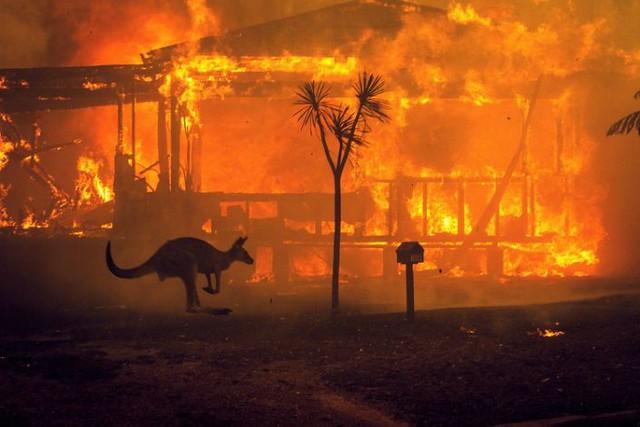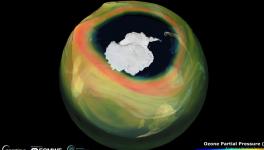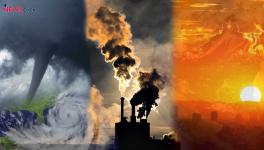Australian Wildfires Raised Global Heat & Broadened Ozone Hole: New Study

A kangaroo rushes past a burning house in Lake Conjola, Australia. Representational Image. Image Courtesy: Flickr
A new study suggests that the massive wildfires in Australia in 2019-2020 caused the atmospheric temperature to rise and could also increase the ozone hole. The study published in Scientific Reports on August 25 says that the plumes of smoke from the wildfires rose temperature by 3 degrees Celsius over Australia, along with a global rise of 0.7 degrees Celsius. The temperature rise lasted for four months both in Australia and at the global level, according to the study. The plumes of smoke may also have broadened the ozone hole.
From December 2019-February 2020, an extreme drought hit Australia. This unprecedented event burnt over 5.8 million hectares, causing widespread devastation of wildlife and croplands. Along with the catastrophic damages in Australia, the fires caused a temperature rise. Importantly, the global temperature increase in the lower stratosphere by 0.7 degrees Celsius was the biggest after the eruption of Mount Pinatubo, which occurred in the Philippines in 1991.
Commenting on the remarkable scale of the wildfires and their impact, Nerilie Abram, a paleoclimate scientist at the Australian National University, said, "The effect was equivalent to the type of impact that we'd see from a moderate volcanic eruption. What we're discovering about the scale of these fires is remarkable."
The scale of the wildfire's impact was so massive that smoke particles rose to the stratosphere. The stratosphere exists at the height of 10-50 kilometres from the surface of Earth, and smoke particles usually can not reach up to this level. But, plumes of smoke emanating from the Australian wildfires reached a height of more than 35 kilometres. This, according to the researchers, pertained to unusual pyrocumulonimbus clouds caused by the fires. The pyrocumulonimbus clouds are generally formed above a heat source, such as a wildfire or a volcanic eruption.
The fore-induced clouds contain lots of black carbon, which can absorb heat and rise to the lower stratosphere like that of a hot air balloon, explained Jim Haywood, a co-author of the study and an atmospheric scientist at the University of Exeter, UK. Once it is formed, the black carbon continues to absorb sunlight and thus warming the air.
Abram explained further, saying that the parts of the Australian coastline had been filled with a haze of smoke for months. He remarked that the scale of the wildfires that happened that year was simply on the extreme.
The team of researchers utilised the data from remote-sensing satellites to observe changes in the distribution of smoke particles in the stratosphere. The team also combined the information obtained from this data with climate models. Their analyses revealed that the model-predicted impact of the smoke on stratospheric temperature did match with the observed temperature hike.
The models were also used to see whether the high-impact fumes from the fires could also cause damage to the ozone layer. The analyses made by the research team indicated that the chemical reactions between the smoke and the ozone impacted the Antarctic Ozone hole by making it bigger.
"The year before the fires, we had a puny little ozone hole, while in 2020, we were taken rather aback because there was a very, very deep ozone hole, explained Haywood, further remarking that the hole lasted for around five months.
The Ozone layer depletion also strengthens the polar vortex, a large region of cold and rotating air encircling both the poles of Earth. In the polar vortex, low pressure and cool air encircle the poles. Strengthening the polar vortex creates a feedback loop, where a stronger polar vortex leads to more depletion of the ozone layer and longer the hole remains open. Ozone layer depletion also causes harmful UV rays to penetrate, causing harm to both human health and the environment. Moreover, warming in the stratosphere can also lead to more ozone layer damage.
Get the latest reports & analysis with people's perspective on Protests, movements & deep analytical videos, discussions of the current affairs in your Telegram app. Subscribe to NewsClick's Telegram channel & get Real-Time updates on stories, as they get published on our website.



















